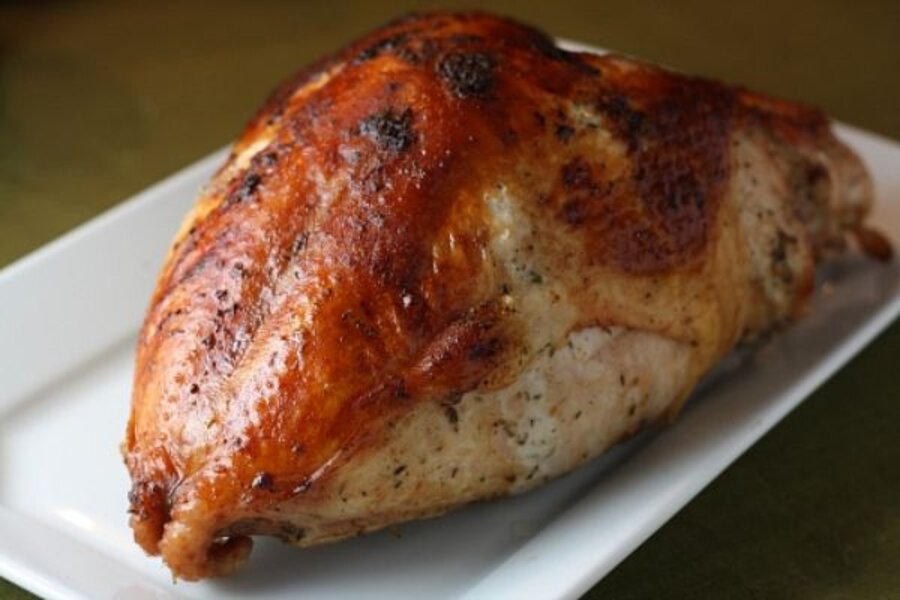Herb roasted turkey breast
1 6-7 pound Turkey Breast (bone in)
1/2 stick Butter, softened
1 Tablespoon Dijon Mustard
1 teaspoon Garlic, minced
1/2 teaspoon Salt
1/2 teaspoon Pepper
1 teaspoon Thyme
1 teaspoon Rosemary
3/4 cup Carrots, coarse chopped
1 Onion, quartered
3/4 cup Celery, coarse chopped
2 cups Chicken Stock
The night before, remove the turkey breast from it’s packaging. Place on a rack in a roasting pan and sit, uncovered in the refrigerator.
Preheat oven to 475 degrees F. In a small bowl, combine the butter, mustard, garlic, salt, pepper, thyme, and rosemary. Rub the herbed butter all over the turkey. Working from the edges, try to loosen the skin and rub some of the butter directly onto the turkey breast. In the bottom of the roasting pan, scatter the carrots, celery, and onion. Add the chicken stock to the bottom of the pan. Place the pan on the middle rack of the oven and roast for 25 minutes. The skin should take on a nice golden browned color. Baste the turkey with the pan juices. Then, lower the heat to 325 degrees F. Periodically, baste the turkey with the juices from the bottom of the pan. (If the bottom of the pan becomes too dry during cooking, add a little more stock.) Continue cooking until the internal temperature reaches 165 degrees. Use an instant read meat thermometer, inserted into a deep part of the breast, to check the temperature. A 7 pound turkey will take approximately 2 hours at 325 degrees, after the initial 25 minutes at 475 degrees. When the turkey is cooked, remove the pan from the oven. Loosely cover the turkey with foil and allow it to rest for about 20 minutes. Meanwhile, prepare the gravy and side dishes.
Serves about 6-8, generously
Turkey Pan Gravy
3 tablespoons Butter
3 tablespoons Flour
Drippings from Turkey
1-1/2 cups Chicken Stock (approximately)
Pour out the turkey juices from the roasting pan. Strain to remove the vegetables. Allow the juices to sit for a few minutes. The fat will rise to the top. Pour off the fat and reserve the remaining juices. Add chicken stock to the juices to make a total of 2 cups liquid. In a saucepan, combine the butter and flour over medium heat, whisking continuously. Cook for a minute or two. Then, whisk in the turkey juice/chicken stock. Bring to a simmer. Cook for 2-3 minutes until the gravy begins to thicken. Taste and adjust seasoning with salt and pepper, as desired.
Makes 2 cups
Now, if you’ve just got to create that beautiful, Norman Rockwell style, picture-perfect bird, here are a few tips for handling that whole turkey:
Do not stuff your turkey. Stuffing your turkey presents a food safety and moist turkey challenge. Since the stuffing is in contact with the raw turkey, it will need to reach a temperature of 165 degrees to be safe. In order to reach this safe temperature, you’ll often end up cooking the turkey longer than necessary.
Instead, bake your stuffing separately and throw a few herbs and aromatics into the turkey cavity; celery, onions, carrots, garlic, thyme, rosemary, etc.
Allow your turkey to sit uncovered in the fridge overnight before roasting. This will help to produce a crispier skin.
Start your turkey at a high temperature (475 – 500 degrees F.) for the first 20-30 minutes, then reduce heat to 325 or 350 degrees F. to finish cooking.
Don’t bother with that flipping the turkey technique you may have seen. In my opinion, it’s more trouble than it’s worth.
To brine or not to brine? Brining your turkey in a solution of salt, water, and other seasonings is said to produce a juicier and more flavorful turkey. There are people who swear by brining to produce the best turkey. I’m not one of those people. I’ve brined and I’ve not brined. In my opinion, the difference is minimal.
But if you’ve got the time and space to do it, go for it. Click here for a useful resource on brining.
Loosely tenting the turkey with foil during cooking can help to prevent over-browning and keep the turkey moist. Be sure to remove the foil during the last 45 minutes to achieve a nicely browned skin.
To be safe, all parts of your turkey should register 165 degrees on an instant read thermometer. Some resources list 180 degrees as the minimal temperature. The FDA recommends 165 degrees as measured in the innermost part of the thigh and wing and the deepest part of the breast.
Let your turkey rest for at least 20-30 minutes before carving. This is a good time to make the gravy and finish reheating your side dishes.
After dinner, throw the whole turkey carcass into a large pit of simmering water. Follow my procedure for chicken soup to make a tasty turkey soup.







